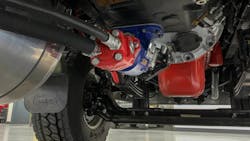The power takeoff unit, more commonly known as a PTO, is a mechanical gearbox connected to the transmission that transfers power from the vehicle’s engine to an auxiliary component such as a hydraulic pump. A PTO is an integral part of many fleet vehicles; without them, processes such as lowering and raising a truck bed or compacting garbage would not be possible. To keep the PTO in prime working condition, fleets must stay on top of maintenance and understand the factors that go into choosing the right PTO for their vehicles.
The power behind the PTO
A PTO draws its power from the vehicle’s engine, but it cannot start transferring that power until it has been engaged. PTOs can be engaged through air pressure, hydraulic pressure, or a cable, explains Luke Hart, customer/employee technical training instructor for Muncie Power Products, a manufacturer of PTOs.
After the engine is running and the PTO has been engaged, the PTO’s output shaft will transfer power to the auxiliary component, therefore enabling whatever application is installed in that vehicle, Hart continues.
Another important aspect of the PTO’s connection to the engine is the PTO provision. This provides access to the engine for the PTO.
“It’s basically a port with hardware to facilitate the transfer of power from the truck into the PTO,” says Nathan Oscarson, commercial truck brand manager for Ford Motor Company.
Ford makes a live-drive PTO provision that includes both stationary and mobile modes for diesel and gasoline engines.
“This means that vehicles spec’d with live-drive PTO can power auxiliary equipment any time the engine is running, whether the vehicle is stationary or moving,” Oscarson says. “Our live-drive power take-off provision uses an output PTO gear connected directly to the transmission’s torque converter impeller hub. We also offer split-shift capability on our diesel powertrains that allows a customer to power two separate accessories while the truck is stationary.”
PTO applications
There are a variety of PTO applications. Hart provides a list of some of the most common hydraulic and mechanical applications.
Hydraulic:
- Dump trucks – standard dumps trucks, side dump trucks, dump trailers
- Utility vehicles – aerial buckets or digger derrick trucks
- Refuse vehicles – side loaders, rear loaders, front loaders, some roll-off trucks
- Recovery trucks – flatbed trucks, wheel lifts, tow trucks, integrated tow trucks
- Snow and ice control – spreaders, snowplows, parallel lift plows, truck wing plows
Mechanical:
- Product pump applications
- Vacuum pump applications
- Pneumatic blower applications
- Air compressor or generator applications
It is also possible for a vehicle to have more than one application, meaning more than one PTO.
“The transmission might have two or three openings, and you could have two or three PTOs on that truck,” says Brad Gulick, regional sales manager, vehicle group, North America, East Region, and Canada for Eaton, a power management company. “One might work the back system on a vacuum excavation unit, and the other PTO might be a pump to run some of the outriggers … on the truck.”
Purchasing considerations
When purchasing an aftermarket PTO, fleets must first and foremost know the vehicle’s transmission make and model number. According to Muncie’s Hart, this will enable fleets to use an online resource to find the transmission and correctly spec out a fitting PTO.
Next, fleets should take into consideration where the PTO will be placed – driver’s side, passenger’s side, top mount, bottom mount, or rear mount opening. In addition, fleets will want to check if the truck has been ordered with a PTO prep package. Vehicles with the prep package typically have a bulge in the floorboard where the PTO will be installed; those without it will have to deform the vehicle floorboard during installation. Only certain types of trucks come with this, Hart notes, but it is a feature that is becoming more popular.
Other factors such as PTO shaft rpm, shaft rotation, and what is being driven by the PTO must be considered. Also, fleets will have to decide how the PTO will be shifted – by air, cable, electric-over-air, or electric-over-hydraulic.
Lastly, Hart says, fleets should have the application specs: the gpm required, the working psi required, the maximum psi, and the engine rpm required for operation. Those numbers will help fleets determine the necessary torque and horsepower for the PTO. With all the information above, fleets will be able to choose the proper PTO for their vehicle with whatever applications they have in mind.
AMTs versus manual transmissions
While a PTO will complete the same tasks regardless of the transmission type with which it’s mated, there are some differences in installation and operation when it comes to installing a PTO on a vehicle with an automated manual transmission (AMT) versus a manual transmission.
“The PTO really doesn’t care whether it’s getting the power from a manual [transmission] or an AMT,” says Tim Bauer, vice president of aftermarket for Eaton. “[When] you bolt it up, it’s virtually the same.”
When it comes to installation, however, Bauer explains there a few differences between the two, such as some sealing differences with the gaskets, the software setup, and some backlash settings that don’t need to be done on an AMT.
Other differences between PTOs on AMTs and manual transmissions include noise level, price, PTO engagement, and ease of use.
Muncie’s Hart explains that due to the larger gear in AMTs, the PTO operates at a louder noise level than manual transmissions. Additionally, PTOs spec’d on vehicles with AMTs will have a clutch shift design, versus manual transmissions which require a mechanical shift type PTO. Also, PTOs mated with AMTs shift using hydraulic pressure, compared to PTOs on manual transmissions which shift using air pressure. It can also be easier to engage a PTO on an AMT because the user simply has to push a button to engage the PTO versus engaging the clutch for a manual transmission.
Common issues and maintenance
Issues always seem to occur at the worst possible times, but with proper spec’ing and installation, following operation instructions, and adhering to maintenance guidelines, fleets can mitigate these issues.
Spec’ing
“If you don’t know the transmission make and model, you can certainly risk damaging the transmission through the PTO being on there,” Eaton's Bauer says.
Improperly spec’ing the PTO can have disastrous results, ranging from the system running inefficiently to breaking down entirely.
“You must know the gallons per minute, the psi, the torque, and the horsepower and speed [of the transmission the PTO is being spec’d to],” Muncie’s Hart says. “With all of those, you can determine a correct PTO.” He also suggests reading over the footnotes on the application page as these will aid in fleets purchasing the right PTO for their vehicles.
Installation
Mounting or installing the PTO incorrectly will also lead to problems. It is important technicians follow the installation manual provided with the PTO to ensure they are properly setting the backlash and connecting the plugs to the right places.
Shifting
Drivers must know how to correctly shift the PTO. If they do not, they could wind up clash shifting, meaning they are trying to engage a mechanical PTO without stopping the transmission gear first, Hart notes. Again, an error like this could lead to damage in the system.
ECU programming
As technology continues to advance, the engine control units (ECUs) in trucks have become more complicated. This can make installing a PTO a bit tricky.
“When you set up a PTO … along with [the installation] being correct, you also have to program the ECU with correct diagnostic software because if it’s not programmed correctly, that can cause failure, it can cause excess fuel consumption, it can cause all sorts of havoc,” Eaton’s Gulick says.
Maintenance
As with every other system within a vehicle, regularly scheduled preventive maintenance is the key to that system’s longevity and functionality.
“You will need to have a regular maintenance check of your PTO,” Hart says. “So clean around all electrical components, make sure [the] electrical components are working, [and] regrease the output shaft at least one to two times a year, depending on the use of the truck.”
Hart also recommends double-checking the torque on every mounting bolt.
Additionally, Bauer suggests visual and auditory inspections to check for leaks, wear, and excessive noise.
By implementing these maintenance procedures, fleets can expect maximum performance and longer life from the PTO.
About the Author
Emily Markham
Assistant Editor | Vehicle Repair Group
Emily Markham is an assistant editor for the Vehicle Repair Group.
With an education based in writing and editing, Markham uses her knowledge to assist with the creation of content for Endeavor Business Media Vehicle Repair Group’s publications—Fleet Maintenance, Professional Tool & Equipment News (PTEN), and Professional Distributor—as well as their website, VehicleServicePros.com.

